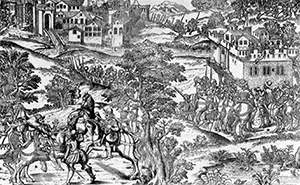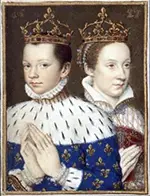The French King Francis II
King Francis II ruled France for a short time in the 16th Century. Punctuating his rule were political intrigue and religious strife. His wife was the famous Mary, Queen of Scots. 
Francis was born on Jan. 19, 1544. His father was the reigning monarch, Henry II, and his mother was Catherine de Medici. A physically weak child, Francis was nonetheless the Dauphin and heir to the throne. He didn't much like academics but did enjoy being outdoors, doing archery and hawking and horse riding. When he was 14, he married Mary, Queen of Scots, whose uncles were Charles, the cardinal of Lorraine, and François, duc de Guise. Mary had been just 6 in 1548 when she was sent to the French court, once the betrothal had been announced; thus, Francis and Mary grew up together at court. The young couple were married at the Cathedral of Notre Dame in Paris, on April 24, 1558. Later that year, England's Queen Mary died and was succeeded by her sister, Elizabeth. Tensions between Catholics and Protestants arose again because Mary had been a Catholic but Elizabeth was a Protestant. Many Catholics in England, France, and Scotland viewed Elizabeth as a usurper, with an illegitimate claim to the throne. Indeed, her own father had declared her illegitimate when he finally had a son. Henry changed his mind on this before he died and named his daughters as his legitimate heirs, and this is how Mary was able to succeed Edward VI on the throne so easily. But the Catholic populations of the three countries wanted to see another Catholic on the throne of England and thought that the one who should succeed Queen Mary of England was Queen Mary of Scotland. Mary, Queen of Scots had her own claim of legitimacy to the English throne, through her grandmother, Margaret Tudor. She was the sister of Henry VIII and had married Scotland's King James IV and had served as regent for her infant son, James V. King Henry II had proclaimed his daughter-in-law Queen of England and his son a king consort. Elizabeth, newly named Queen of England, took little notice of the fact. Henry II, who had little leverage or money by this point, was forced to acquiesce, recognizing Elizabeth as the English monarch with the Treaty of Upsettlington. On June 30, 1559, the king died, as the result of injuries sustained in a jousting tournament. Francis became king but was 15 and so his mother, Catherine de Medici, served as regent. 
One thing that the young king really liked doing was hunting. He liked taking his new wife with him, and so they went on several hunts together. While they were thus occupied, Catherine and the Guise family were running the government, with François running the army and Cardinal Charles taking care of financial and political matters. This didn't sit well with a number of people in France, particularly the Huguenots, who had been victims of persecution by Henry's father. Francis had chosen to maintain those policies, and the Huguenots had had enough. On March 17, 1560, a large group of people, Huguenots among them, stormed the royal cháteau at Amboise; royal security had no trouble stopping the attack, and the king later ordered the leaders of the attack executed. Rather than keep the peace, these executions served to inflame the populace, and riots proliferated in various cities, notably Lyon and Provence. King Francis sent royal troops to disperse the rioters. The army was able to contain such internal discontent because it wasn't having to fight external wars. Henry II had ended the nearly four decades of fighting with the Habsburg Empire by signing the Peace of Cateau-Cambrésis; Francis continued to hand over territories as specified by that treaty. The country still had an enormous war debt, and Francis was careful to avoid the kind of austerity program that had made his father unpopular in the last years of his reign. 
One area of contention that remained was in Scotland. Mary was technically Queen of Scotland, but she was Francis's wife and queen consort of France; while she thus ruling at the French court, her mother, Marie of Guise, was regent in Scotland. An uprising by Scottish nobles forced the regent Marie into hiding in a fortress at Dunbar, and Francis sent French troops to put down the uprising. A bit later, Elizabeth sent the English navy to blockade the French port of Leith and then sent the English army to besiege the city. France had few options at this point and agreed to the Treaty of Edinburgh, by which Francis pledged to remove his troops from Scottish soil. Francis had struggled with poor health for his entire life. He took a turn for the severely worse in November 1560, suffering fainting spells. He never recovered and died on December 5. He had no children, and so his younger brother Charles, then only 10, became the next King of France. |
|
Social Studies for Kids
copyright 2002–2024
David White




